Which Date Filter Option Enables You To Restrict The View To Only Dates That Occur In March Of 2018?
Filtering is a useful fashion to come across only the data that you want displayed in Admission databases. You can use filters to display specific records in a course, report, query, or datasheet, or to print only sure records from a report, table, or query. Past applying a filter, you are able to limit the information in a view without altering the design of the underlying object.
In this article
-
How filters are useful
-
Select and apply a filter blazon
-
Remove or reapply a filter
-
Articulate a filter
-
Salvage a filter
How filters are useful
Since the view y'all become afterward you apply a filter contains only records with the values that yous selected, the residuum of the data remains hidden until y'all clear the filter.
Note:Columns in datasheets and controls in forms and reports that are bound to expressions do not support filtering.
There are several types of filters and some of them are easy to utilize and remove. Access contains some common filters that are built into every view. The availability of filter commands depends on the blazon and values of the field.
For case, to view the records of people whose birthdays autumn during a specific calendar month, click the BirthDate column, on the Home tab in the Sort & Filter group, click Appointment Filters, and and then select the required date period.
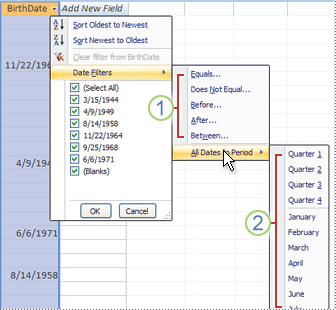
1. The filters that are available to you depend on the information blazon in the selected cavalcade.
2. All Dates in Menstruation filter ignores the day and year portion of the appointment values.
In this filtered view, you see simply the records in which the month portion of the BirthDate field is set to April.

i. The filter icon in the cavalcade header and the tape navigator bar indicates that the current view is filtered on the BirthDate column.
2. In the datasheet view, when you hover, the mouse, over the column heading, yous will encounter the current filter criterion.
Note: When you lot apply a filter to a column that is already filtered, the previous filter is automatically removed. Though merely a unmarried filter can be in result for a field at a time, y'all can specify a different filter for each field in the view.
For example, to encounter the names of contacts that alive in the UK whose birthdays fall in April, y'all tin can filter the Contacts tabular array on the CountryRegion field and as well on the BirthDate field. When yous filter multiple fields in a unmarried view, the filters are combined past using the AND operator, like this:
CountryRegion = Great britain AND month of BirthDate = April
To revert to unfiltered view: Remove the filters. Removing a filter temporarily removes it from the view, so that you tin switch back to the original, unfiltered view.
To switch between the filtered and unfiltered views: in the Sort & Filter group on the Dwelling tab, click Toggle filter.
To permanently remove a filter from a view: Clear the filter. To learn how to clear filters, see the section Clear a filter.
Filter settings will remain in consequence until you lot shut the object, fifty-fifty if you lot switch to another view of the object. In other words, if you filter a form in Datasheet view, the filter settings volition still be in effect even if yous switch to Form view or Layout view, and will remain in effect until you shut the form. If you lot salve the object while the filter is practical, it will exist available the side by side time that you open up the object. To learn about saving a filter, see the department Save a filter in this article.
Top of Page
Select and utilize a filter blazon
You tin select from several fix-to-utilize filters for a data type. These filters are available as menu commands in the following views: Datasheet, Form, Report, and Layout. In addition to these filters, y'all can also filter a form or datasheet by completing a course (called Filter by Course).
If you lot desire more than flexibility, and if yous are comfortable writing expressions, you tin create your ain filters by using the options on the Filter document tab.
Select from the following types of filters:
Common filters: To filter for specific values or a range of values.
Filter past Selection: To filter all the rows in a table that comprise a value that matches a selected value in a row by filtering the datasheet view.
Filter by form: To filter on several fields in a form or datasheet, or if you lot are trying to observe a specific record.
Advanced filter: To filter type where you ascertain custom filter criteria.
Note: If you do non come across the filter commands in any of the views, the designer of the class or database might have disabled filtering. Contact the designer for further assist.
Common filters
Except for OLE Object fields and fields that display calculated values, all field types offering common filters. The list of filters that are bachelor depends on the selected field'southward data type and values.
Right-click the field you lot want to filter. To filter on multiple columns or controls, you lot must either select and filter each cavalcade or control separately, or use an advanced filter choice. See the Filter by form and Advanced filters sections in this commodity for more than information.
For example, to come across the filters available for the BirthDate field, on the Home tab, in the Sort & Filter grouping, click Filter
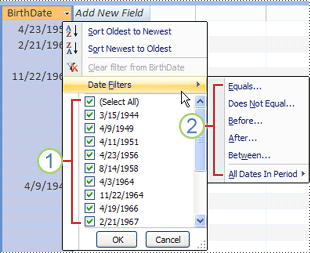
1. To filter for specific values, use the check box list. The list displays all the values that are currently displayed in the field.
2. To filter for a range of values, click one of these filters, and specify the required values. For example, to see birthdays that fall between the current engagement and the end of the yr, click Betwixt, and then specify the appropriate showtime and end dates in the Betwixt dialog box. To meet all birthdays that fall on a specific appointment, click the appointment and all the birthdays that fall on that specific date are displayed.
It is important to note that the values in a date field have an touch on on the list of blazon-specific filters. If the most recent date value in a engagement field falls within the by two years, you see a longer, more detailed filter list. If none of the dates in a field is less than two years old, you meet the shorter filter list.
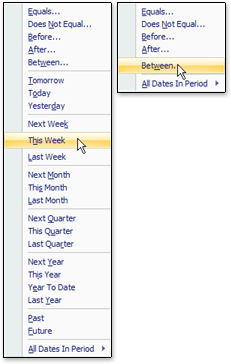
Note:Blazon-specific filters are non available for Yes/No, OLE object, and attachments fields. The values list is not available for memo fields, or for fields that contain rich text.
Apply a common filter
-
Open a table, query, grade, or written report in any of the post-obit views: Datasheet, Form, Report, or Layout.
-
Brand sure that the view is not already filtered. On the record selector bar, verify that either the Unfiltered or the dimmed No Filter icon is present.
Tip: To remove all the filters for a particular object, on the Dwelling house tab, in the Sort & Filter group, click Advanced, and then click Articulate All Filters.
-
Click anywhere in the column or control that corresponds to the beginning field that you want to filter and, on the Home tab, in the Sort & Filter grouping, click Filter
To use a common filter: Point to Text (or Number or Engagement) Filters, and then click the filter that you want. Filters such as Equals and Between prompt y'all to enter the necessary values.
Tip: Certain characters, such as *, %, and ?, have a special significant when specified in a filter text box. For example, * represents a cord of characters, so the string a* will match whatever cord that begins with a, and not only the literal cord a*. To disregard the special meaning of a graphic symbol, enclose information technology in square brackets [], like this: a[*]. Databases that use the ANSI-89 standard treat *, ?, [, ], !, -, and # as special characters. Databases that use the ANSI-92 standard care for %, _, [, ], ^, and - equally special characters. You tin can utilize either standard with Admission, but you lot cannot mix the two standards (due east.m., ? a*) in a particular expression..
To utilise a filter based on field values: Clear the check boxes side by side to the values on which you do not want to filter, and then click OK.
To filter on one or but a few of values in a long list, first clear the (Select All) check box and so select the values you want.
To filter for goose egg values (a null value indicates the absence of data) in text, number, and engagement fields: In the cheque box list, articulate the (Select All) cheque box, and and then select the bank check box next to (Blanks).
Filter by Selection
To see all the rows in a table that contain a value that matches the value in a row, you can speedily filter the datasheet view by selecting a specific value, and and so clicking the Selection command. The drop-down list displays the available filtering options. These options will vary, depending on the data type of the selected value. Another fashion to access the selection filter options is to correct-click the specific cell.
For example, if the value 2/21/1967 is currently selected in the BirthDate field, on the Habitation tab, in the Sort & Filter group, click Choice to display the filter by selection commands, and and then select your filtering option..
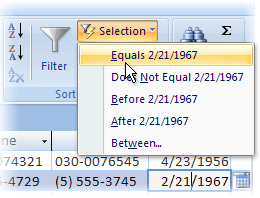
The listing of commands also depends on how much of the value is selected. For example, if yous select simply some of the characters in the value, you see a unlike listing of commands, depending on which role of the field yous selected.

1. Filter using the starting time of a field value...
two. ...the center of a field value...
3. ...or the end of a field value.
Note:Filtering on a partial selection is non available for multivalued fields. The Selection command is not available for attachments.
To remove a filter, on the Home tab, in the Sort & Filter group, click Toggle Filter, or click Advanced and click Articulate All Filters.
Utilise a filter based on a selection
-
Open a tabular array, query, form, or report in whatsoever of the following views: Datasheet, Grade, Report, or Layout.
-
Make sure that the view is not already filtered. On the record selector bar, verify that either the Unfiltered or the dimmed No Filter icon is present.
-
Move to the record that contains the value that you desire to use as part of the filter, so click inside the column (in Datasheet view) or control (in Form, Study, or Layout view).
To filter based a partial pick; select the characters that you want, on the Domicile tab, in the Sort & Filter group, click Pick, and so click the filter you want to apply.
Filter past grade
This filter is useful when you want to filter on several fields in a class or datasheet, or if you are trying to find a specific record. Access creates a blank grade or datasheet that is similar to the original grade or datasheet, and then allows y'all to consummate as many of the fields as yous want to. When you are washed, Admission finds the records that contain the specified values.
Note:Yous cannot specify field values for multivalued fields using filter past form, nor for fields with Memo, Hyperlink, Yep/No, or OLE Object data type, although you can specify values for other fields in the recordset.
For instance, if you want to find all Customer records where the contact person's championship is Owner, and that person is located either in Portland or in Eugene, open up the Customers datasheet or course and, on the Home tab, in the Sort & Filter group, click Advanced, and then click Filter by Course.
Enter the first set of values, then click the Or tab at the lesser of the datasheet or form, and then enter the next fix of values. Note that if yous want a field value to operate every bit a filter independently of other field values, you must enter that value on the Look for tab and each Or tab. Each Or tab represents an alternating set of filter values.
To run across just the records matching your input: On the Abode tab, in the Sort & Filter grouping, click Toggle Filter .
Utilise a filter by filling out a class
-
Open a table or query in Datasheet view, or a form in Grade view.
-
Make sure the view is not already filtered. On the record selector bar, verify that either the Unfiltered or the dimmed No Filter icon is nowadays.
-
On the Home tab, in the Sort & Filter grouping, click Advanced, then click Filter by Course on the shortcut carte du jour.
-
Depending on whether you are working in Datasheet view or in Class view, do i of the post-obit:
Datasheet view: Click the first row in the column on which yous desire to filter, click the arrow that appears, and then select a value. To add additional values, just click the Or tab at the bottom of the datasheet and select another value.
Class view: Click the arrow that appears in the command, and select a value on which to filter. To add boosted values, click the Or tab at the bottom of the form and select another value.
Tips: You cannot specify field values for multivalued fields past using the filter past grade, only you lot tin can specify values for a non-multivalued field in the recordset.
-
To specify a listing of possible values for a field, use the or operator. For instance, specify "Portland" or "Oregon" in the City field to filter for records containing either value.
-
To filter based on the status of a control, such as a check box or button, click the control so that it is in the state that y'all want. To return the control to a neutral position, so that information technology won't be used as a criterion for filtering records, ensure that it is unavailable (appears dimmed).
-
To filter for records that have nothing (missing), not-null, blank (empty or ""), or nonblank values, type Is Zippo, Is Non Naught, "", or Non "" in the field.
-
-
If you desire to specify ii alternate sets of criteria, for example, to only meet the names of contacts whose CountryRegion value is USA and whose birthdays fall in Apr, you can do any of the post-obit:
-
To call up all records that meet whatsoever one of multiple sets of criteria, specify the criteria past inbound the first fix of criteria, Click the Or tab, and then enter the next set of criteria. Note that if you desire a field value to operate as a filter independently of other field values, y'all must enter that value on the Expect for tab and each Or tab. In other words, the Look for tab and each Or tab represents an alternating set of filter values.
-
Also note that each time you add a field benchmark to the Or tab, Access creates another Or tab. This enables y'all to specify several "or" criteria. The filter returns any record that contains all of the values specified on the Look for tab, or all of the values specified on the first Or tab, or all of the values specified on the second Or tab, and and then on.
-
To remove a filter and testify all records, click Toggle Filter once more.
To change a filter past course, click Avant-garde, then click Filter By Grade again. The current filter criteria set is displayed.
Advanced filter
On occasion, yous might want to apply a filter that is an advanced filter type and y'all might take to write the filter criterion yourself. For example, to discover records that contain dates occurring during the past seven days or the past six months.
Using the advanced filters requires writing expressions. Expressions are similar to formulas in Excel, and to the criteria that yous specify when designing a query.
Ane case of where you lot might utilize an avant-garde filter is, to discover the names of those contacts whose birthdays occurred during the past vii days. Subsequently y'all apply an advanced filter, yous can further limit the results to those whose country/region is U.s.a..
Employ an advanced filter
-
Open a table, query, form, or study in any of the following views: Datasheet, Course, Report, or Layout.
-
Brand sure that the view is non already filtered. On the record navigator bar, verify that No Filter appears dimmed (is unavailable). If the record navigator bar is not visible, click Advanced in the Sort & Filter grouping on the Home tab, and then click Clear All Filters (if Clear All Filters appears dimmed, there are no filters in effect).
-
On the Home tab, in the Sort & Filter group, click Avant-garde so click Advanced Filter/Sort on the shortcut menu.
-
Add together the fields on which you want to filter to the grid.
-
In the Criteria row of each field, specify a criterion. The criteria are applied as a ready, and only records that friction match all of the criteria in the Criteria row are displayed. To specify alternating criteria for a single field, type the offset criterion in the Criteria row and the second criterion in the Or row, and and then on.
Tips:
-
The entire set of criteria in the Or row is applied as an alternative to the set of criteria in the Criteria row. Any criterion that you want to be applied for both sets of criteria must be typed in both the Criteria row and the Or row. Click Toggle Filter to meet the filtered rows.
-
A good way to learn to write criteria is to apply a common filter or a filter based on selection that produces a upshot that is close to what you are looking for. Then, with the filter applied to the view, display the Filter object tab
-
Special commands on the Filter document tab
Ii special commands are available to you on the Filter document tab. When you right-click anywhere to a higher place the pattern filigree on the tab, the Load from Query and Save As Query commands are bachelor on the shortcut bill of fare.
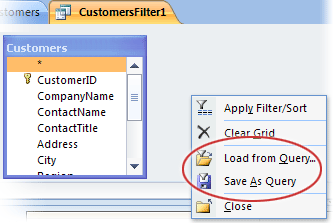
The Load from Query command loads the design of a selected query into the filigree. This lets you utilize the query criteria every bit filter criteria.
The Save As Query command lets y'all save the filter settings as a new query.
Pinnacle of Folio
Remove or reapply a filter
To switch to the unfiltered view of data, remove the filters by clicking Filtered on the record navigator bar to revert to the full view.
When you lot remove the current filters, the filters are temporarily removed from all of the fields in the view. For case, if you starting time apply filters on the CountryRegion and BirthDate fields, and and so remove the filters, y'all see all of the records again.
To reapply the most recent filters, click Unfiltered on the tape navigator bar.
Elevation of Folio
Clear a filter
Clear a filter when you no longer need it. Clearing a filter deletes it from the view, and you tin can no longer reapply it by clicking Unfiltered on the status bar. Y'all tin can clear a single filter from a single field, or clear all filters from all fields in the view.
-
To clear a single filter from a unmarried field: Correct-click the filtered cavalcade or control, and and so click Clear filter from field name.
-
To clear all filters from all fields: On the Home tab, in the Sort & Filter group, click Advanced, and then click Clear All Filters on the shortcut menu.
Top of Folio
Save a filter
It might be useful to relieve a filter if you will be using it again. The filter settings that are in effect at the time when you close a table, query, form, or report are automatically saved along with the object, and they are available for reapplying. However, by default, the filter settings are non automatically applied for you when yous next open the object.
To ensure that the current filters are automatically applied when y'all adjacent open a table, query, form, or report, from the object'south property canvass, set up the object's FilterOnLoad property to Yes. The FilterOnLoad property is applied the next time you open the object. Whenever you change this setting, you must close the object and reopen information technology in social club to utilize the new setting.
Note: The FilterOnLoad property setting is only applied when the object loads. Setting this holding for an object in Design view and then switching to another view will not crusade the setting to exist applied. Yous must shut and reopen the object for changes to the FilterOnLoad property setting to take effect..
Top of Page
Which Date Filter Option Enables You To Restrict The View To Only Dates That Occur In March Of 2018?,
Source: https://support.microsoft.com/en-us/office/apply-a-filter-to-view-select-records-in-an-access-database-2a493ded-e544-4144-9103-b9b1d1865147
Posted by: zanderspronful1972.blogspot.com



0 Response to "Which Date Filter Option Enables You To Restrict The View To Only Dates That Occur In March Of 2018?"
Post a Comment